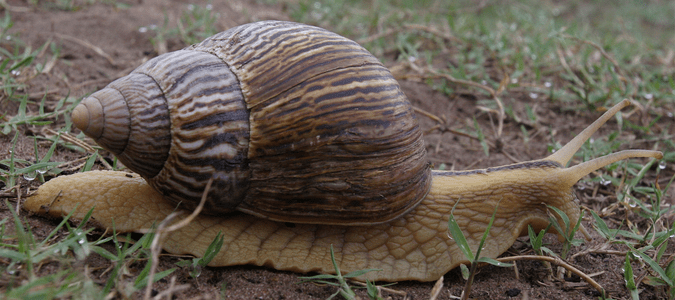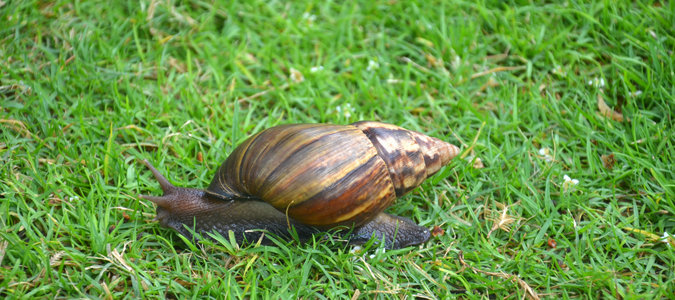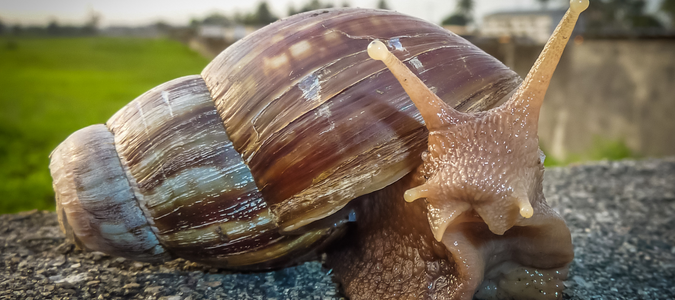What Do Giant African Land Snails Look Like?
What Do Giant African Land Snails Eat?
Do Giant African Land Snails in Florida Carry Diseases?
The Ideal Habitat for the Giant African Land Snail
Giant African Land Snails in Florida
As mentioned above, Giant African Land Snails were first discovered in Florida in 1969. The state spent $1 million to eradicate them, and it took almost a decade to fully wipe out the invasive species.
The snails came back in 2017, and this time the state spent $23 million to eradicate them over ten years. It is currently unknown how the Giant African Land Snail population makes its way to Florida. Owning the snails as a pet is illegal, as is importing them without the proper permits.
In June 2022, Giant African Land Snails were once again discovered in Florida, this time in Pasco County. Since then, the state discovered over 1400 snails. The state set up a quarantine zone to make it illegal to move them out of Pasco County.
It is worth noting that this new Giant African Land Snail infestation is different from previous ones. Instead of having a dark gray or brown body, the most recent snail population have cream-colored bodies.
This color is more common in the illegal pet trade industry. This is where this current infestation was suspected to originate.
The state of Florida is taking a multi-step approach to dealing with the most recent Giant African Land Snail infestation. For the next year and a half, all properties where the snails are found will be treated with a snail and slug solution called metaldehyde.
Specially trained dogs are also used to sniff out the snails. Once the last snail is eradicated, the state will continue monitoring the properties for the next two years.
If you live in or near Pasco County, Florida and see a Giant African Land Snail, contact the Florida Department of Agriculture and Consumer Services. Remember that you should not touch or move the snails since they could carry dangerous diseases.
The Breeding Habits of Giant African Land Snails
Giant African Land Snails are eager breeders, which is one reason why they are an invasive species. The snails are hermaphrodites, meaning they have both male and female reproductive organs.
They can technically fertilize themselves, but most snails still rely on a partner for fertilization. However, during intercourse, both snails can technically fertilize each other, although it does not always happen that way.
Breeding usually takes place at night, and the snails lay eggs between one to three weeks after intercourse. Each snail can lay 100 to 500 eggs per reproductive cycle. They hide the eggs in a nest that is either underground or covered in rocks or shrubbery.
The eggs hatch around two weeks after laying. The parent snails do not provide any care to the newly hatched snails.
Adult Giant African Land Snails can lay eggs around six times per year. On average, they lay around 200 eggs each time, equally 1200 eggs in one year. When it comes to hatching, these snails have a high success rate, which is why their populations grow so rapidly.
What Do Giant African Land Snail Eggs Look Like?
Giant African Land Snails eggs are white or yellow-colored and between five and six millimeters in diameter. They can lay eggs every two to three months. Since these snails lay around 200 eggs per reproductive cycle, you will always see a lot of them together.
However, Giant African Land Snails often lay their eggs in underground nests or hide them in the shrubbery. If you see their eggs on your property in Florida, contact the Florida Department of Agriculture and Consumer Services right away.
What Should Florida Residents Do About Giant African Land Snails?
As a Florida resident, it’s important to understand the risks involved in a Giant African Land Snail infestation. These pests are big eaters and can damage the Florida ecosystem, agricultural systems and private properties.
Knowing how to identify these pests by their appearance, habitats, and breeding habits is an important part of controlling the infestation. However, if you see a Giant African Land Snail on your Florida property, remember not to touch it as it can carry serious diseases that are dangerous to humans.
It is easy to feel overwhelmed by the risk of discovering Giant African Land Snails on your property in Florida. You can rest assured knowing that the Florida Department of Agriculture and Consumer Services is on top of the recent infestation. They have quarantined the properties where the snails are so that the infestation cannot continue to spread. Their multi-step strategy to eradicate the snails has worked twice before, and it will work again.


